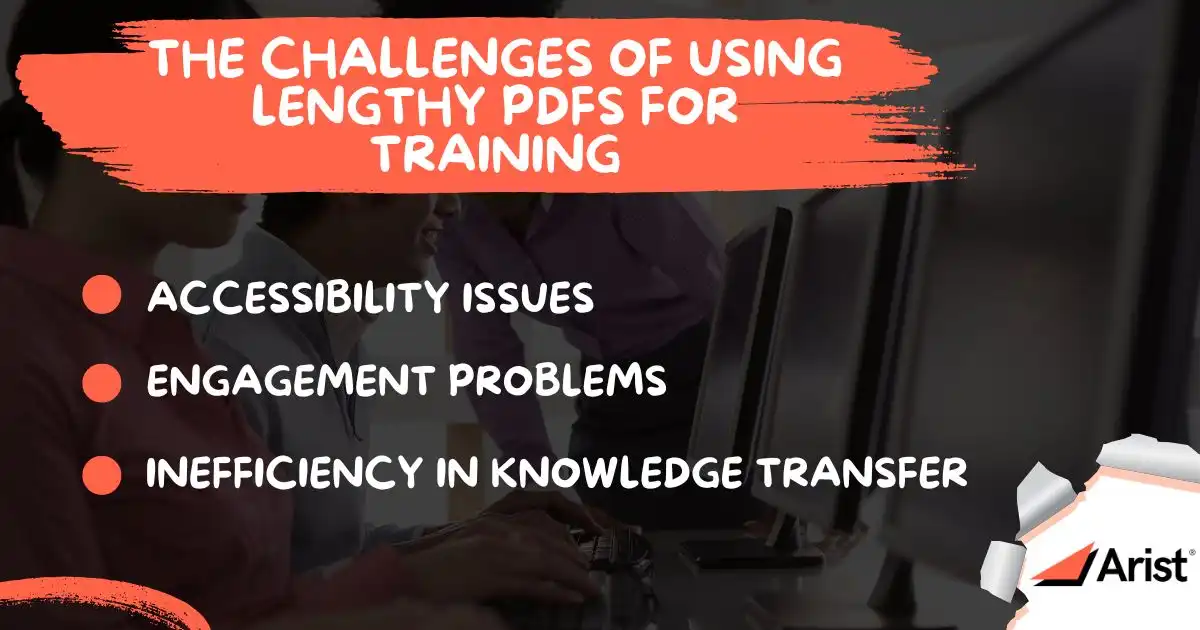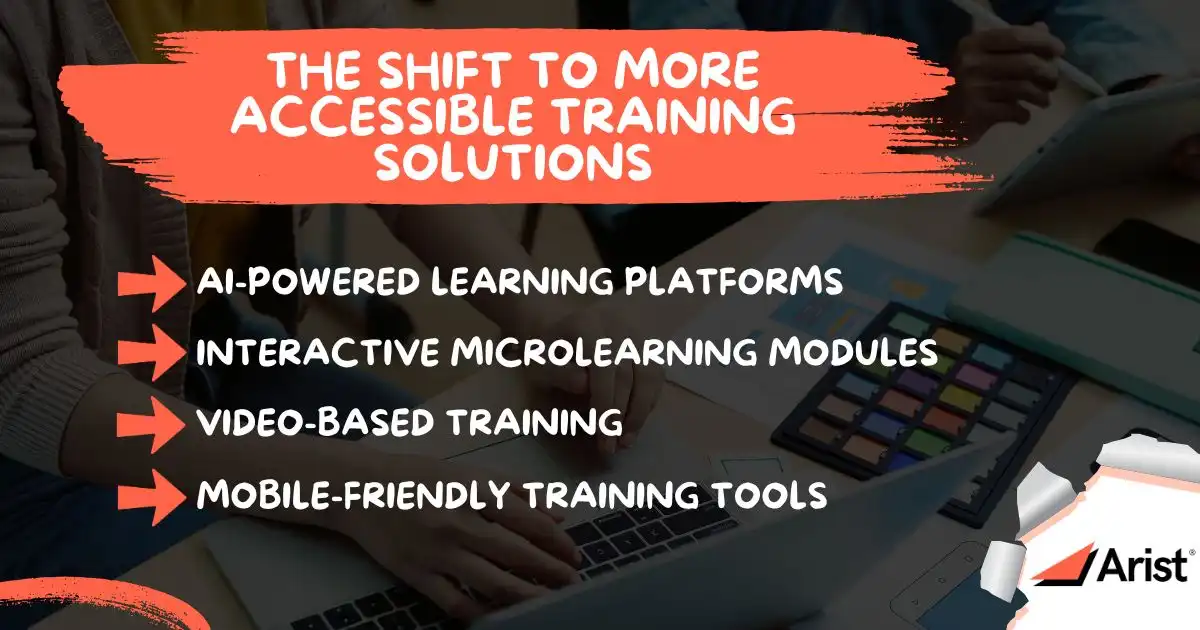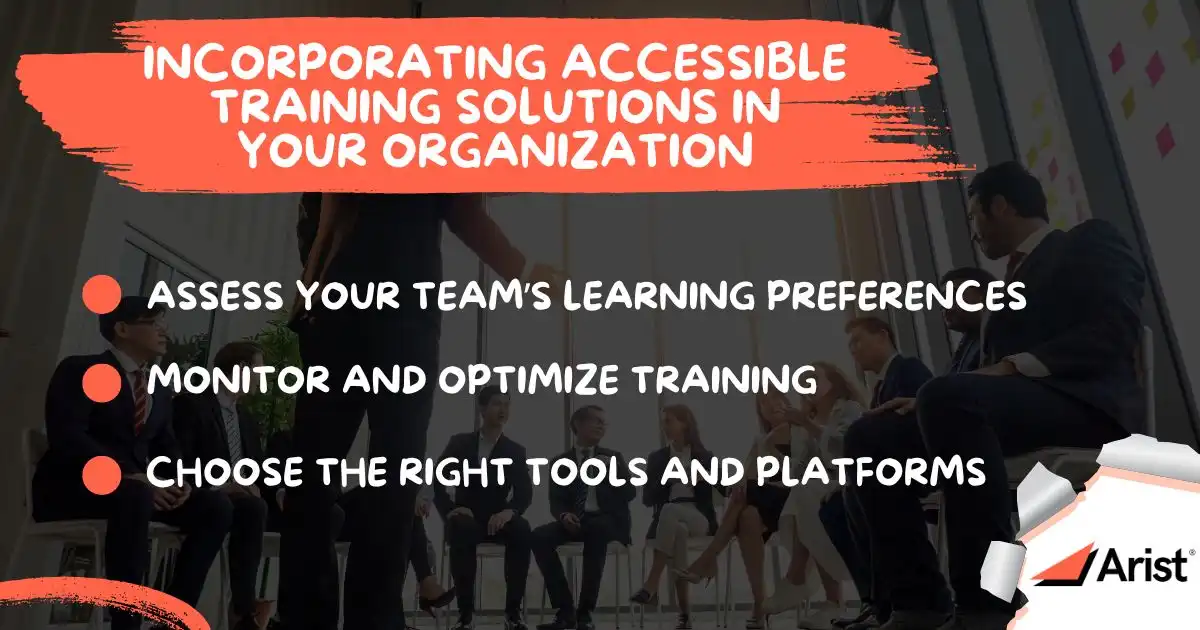How To Make Job Training More Accessible: Ditch Lengthy PDFs
In modern workplaces where time is of the essence and attention spans are shorter, lengthy training no longer holds the same value it once did—making it disengaging and hard to manage and an inefficient tool for modern learners.
Companies must maximize more accessible, interactive, personalized training methods to keep employees engaged and motivated. To transform the way employees learn and boost overall effectiveness, how about ditching the old ones in favor of smarter training solutions?
The Challenges of Using Lengthy PDFs for Training

Lengthy PDFs, once a popular information-sharing method, are no longer the most effective way to engage and educate employees. Companies face challenges when relying on PDFs for training, and it’s time to look for better alternatives.
Accessibility Issues
While PDFs are useful for sharing documents, they often present challenges when accessed on mobile devices or across different platforms. Navigating lengthy PDFs can be frustrating for employees needing quick and seamless access to training content, especially on the go.
Whether on a smartphone, tablet, or different operating system, PDFs may not always display correctly or be easily read. Moreover, searching for specific content within a lengthy PDF can be time-consuming. If employees need to find a particular section or answer a specific question, it’s not as simple as it would be with a more interactive or searchable format.
Engagement Problems
Another drawback of using lengthy PDFs for training is their inability to engage employees effectively. PDFs are static documents that offer little interactivity. Without visuals, quizzes, or multimedia, employees are left to sift through blocks of text without much stimulation. This can lead to disengagement, especially when training materials are dense or overly technical.
Employees may struggle to retain information from long, text-heavy documents because they cannot actively engage with the material or test their knowledge. This often results in poor knowledge retention, which means employees cannot apply what they've learned in real-world scenarios.
Inefficiency in Knowledge Transfer
Regarding knowledge transfer efficiency, lengthy PDFs are slow to distribute, especially in large organizations where you need to send training materials to hundreds or even thousands of employees. If any changes need to be made, those updates have to be manually implemented and redistributed to all employees.
This makes it an inefficient option in fast-moving industries that require real-time updates. It also can't track employee progress or provide feedback on how well they absorb the information. Without built-in tracking or assessment tools, managers cannot know if employees have truly understood the content, which can lead to gaps in learning or poor performance.
The Shift to More Accessible Training Solutions

Training employees is fundamental to improving performance and ensuring long-term organizational success. The shift to more accessible, interactive training solutions is here, offering businesses a way to enhance their training efforts and support their teams more effectively. Adopting accessible training solutions is essential for companies looking to modernize their employee training.
AI-Powered Learning Platforms
One of the most significant advantages of shifting away from static PDFs is the introduction of AI-powered learning platforms. These platforms offer a personalized learning experience, tailoring content to meet individual employees' specific needs and learning styles. With real-time updates, AI platforms ensure:
Availability of current and relevant information.
Instant feedback is provided as employees engage with the material.
Reinforce key concepts and improve knowledge retention.
AI ensures that each employee receives a training experience that adapts to their progress and performance, increasing the likelihood of long-term success and faster learning.
Interactive Microlearning Modules
Microlearning solves this problem by breaking down content into shorter, digestible chunks that employees can complete in small bursts. Bite-sized lessons can be quickly absorbed, making it easier for employees to fit training into their busy schedules.
Interactive microlearning modules also promote engagement by incorporating quizzes, simulations, and activities that allow employees to participate actively in the learning process. This approach ensures the learning experience remains focused, accessible, and engaging.
Video-Based Training
Videos are an excellent way to present complex ideas and procedures in a visually stimulating way. Research has shown that visual and auditory learning significantly improves information retention, making videos valuable for employee training.
Video-based training allows employees to see real-life demonstrations and examples of concepts in action, making the material easier to digest and understand. Additionally, it can break down complicated information into manageable segments, allowing employees to learn at their own pace. PDFs, however, can be dry and difficult to understand, especially for more technical or complex subjects.
Mobile-Friendly Training Tools
Employees are often on the move and need access to training materials whenever and wherever they need them. Mobile-friendly training tools ensure that employees can access learning content from any device, whether working remotely, traveling for work, or at the office.
Learning on the go increases flexibility and makes it easier for employees to fit training into their daily routines. They no longer need to be tied to a desktop or rely on lengthy PDFs that are cumbersome to open on mobile devices. Mobile-friendly training solutions empower employees to engage with the material conveniently, resulting in a more effective and accessible training process.
To learn how to build effective learning reinforcement strategies, read our blog “How to Build Effective Learning Reinforcement.”
Incorporating Accessible Training Solutions in Your Organization

Accessible training ensures that employees can engage with content in ways that are tailored to their preferences, at their own pace, and on any device. Here’s how companies can implement accessible training solutions that will empower their teams and drive better results.
Assess Your Team’s Learning Preferences
Start by surveying your team to understand the most effective formats and methods. Some might prefer auditory materials, such as podcasts or webinars, while others could benefit more from kinesthetic learning—engagement through physical activity, like role-playing or simulations. Identifying different learning styles will help you design a more inclusive training program.
For instance, if you discover that a large portion of your team is visual learners, incorporating video-based learning and infographics will improve engagement and retention. On the other hand, if your employees are predominantly kinesthetic learners, consider adding more interactive training modules. By understanding your team's preferences, you can curate training materials that maximize effectiveness and ensure that the content resonates with your employees.
Monitor and Optimize Training
To measure continuous improvement, use analytics tools to track employee progress and measure the effectiveness of your training initiatives. By collecting data on completion rates, test scores, and employee engagement, you can identify knowledge gaps and areas for improvement. This allows you to refine your training content and ensure it aligns with your business objectives while keeping the material relevant and up-to-date.
AI-driven platforms make it easy to refresh content quickly and efficiently, ensuring that employees always have access to the latest information. With real-time updates and dynamic content, you can keep your training program agile, responsive, and aligned with organizational changes. By optimizing your training program, you empower your employees to stay informed and adapt to new challenges, leading to improved performance and long-term success.
Choose the Right Tools and Platforms
The next step is choosing the right tools and platforms to support your training initiatives. A good starting point is identifying AI-driven platforms and tools that provide personalized learning experiences. These platforms adapt to individual employees' progress and needs, offering a more tailored approach than traditional, static PDFs or one-size-fits-all training sessions. Personalized learning paths ensure that employees receive the most relevant training based on their roles, experience, and learning pace, significantly boosting engagement and retention.
Platforms like Arist integrate seamlessly with existing systems and ensure the training content is accessible across various devices. This allows employees to engage with the content whenever and wherever it’s convenient, offering the flexibility to balance training with their daily responsibilities. When selecting the right training tools, prioritize platforms that make learning accessible, scalable, and adaptable to different learning styles and team structures.
Maximize Your Training for Accessible & Engaging Solutions
In the digital age, accessible, engaging training is essential for maintaining productivity and enthusiasm across your team. By moving away from outdated PDFs and embracing modern, interactive training methods, you can equip your employees with the necessary skills in a format that works for them.
Arist’s AI-powered training solutions ensure that your team gets the right content, boosting engagement, retention, and overall performance. Book a demo today and equip your team with the tools they need to succeed.
Arist Team
Bring
real impact
to your people
We care about solving meaningful problems and being thought partners first and foremost. Arist is used and loved by the Fortune 500 — and we'd love to support your goals.
Curious to get a demo or free trial? We'd love to chat:


